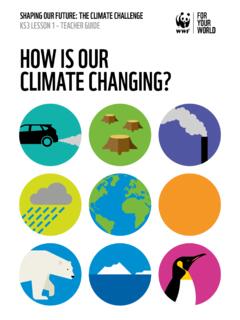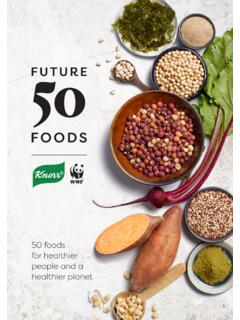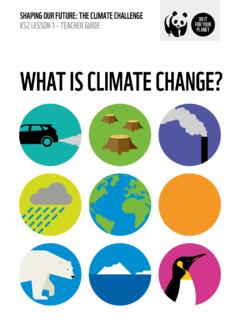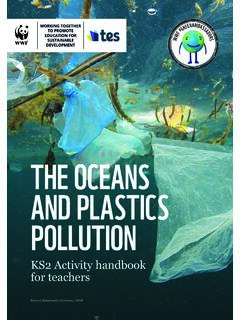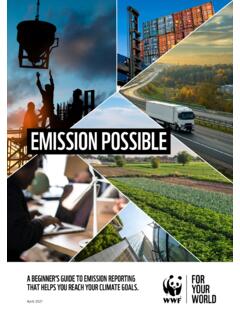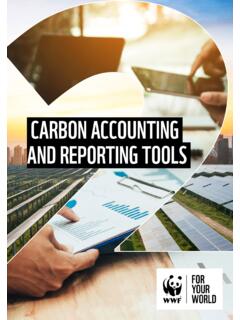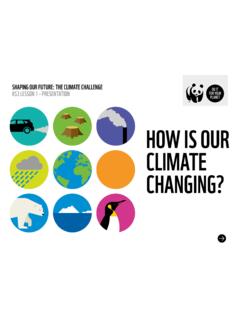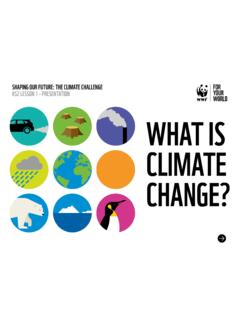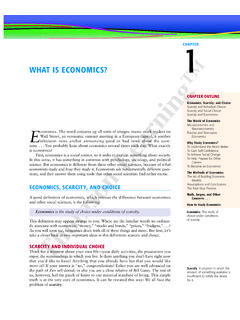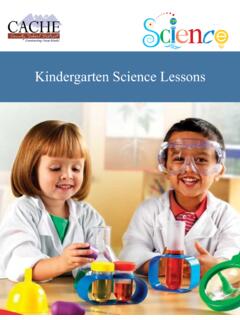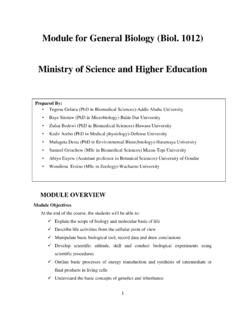Transcription of INTRODUCTION TO CLIMATE CHANGE
1 TEACHER ACTIVITY GUIDE FOR AGES 7-11 INTRODUCTION TO CLIMATE CHANGE The word CLIMATE means the long-term weather patterns for a particular area. On Earth we have different climates depending on how far away you are from the equator and other factors like the movement of the ocean and the Earth s tilt. Regions closest to the equator tend to have very hot climates whereas regions nearest to either of the poles have very cold scientists have been measuring the Earth s CLIMATE directly for over 100 years by monitoring temperature and rainfall. CLIMATE scientists also use evidence in the Earth s rock layers, fossil record and ice cores to study the Earth s CLIMATE back into geological history, 100,000s of years ago! CLIMATE CHANGE (sometimes called global warming) is the process of our planet heating up.
2 Our planet has already warmed by an average of 1 C in the last 100 years and if things don t CHANGE , it could increase by a lot more than that. This warming causes harmful impacts such as the melting of Arctic sea ice, more severe weather events like heatwaves, floods and hurricanes, rising sea levels, spread of disease and the acidification of the IS CLIMATE CHANGE ? Marcio James / WWF-Brazil / Ole Jorgen Liodden / WWF Tiffany Boyd Adriano Gambarini / WWF-Brazil2 Photo credits for front cover: Shutterstock / Soonthorn Wongsaita / WWF, / Doug Gimesy / WWF, / WWF-Aus, WWF / Sindre Kinner d, Marcio James / WWF-Brazil, WWF Intl. / Greg Marinovich / The Stand, WWF-Indonesia / Natalie J. Tangkepayung, Wild Wonders of Europe / Ole Joergen Liodden / WWF, Chris Ratcliffe / WWF-UK, Tiffany Boyd, John E.
3 Newby / WWF, WWF Intl. / Timothy Shivers, IS CLIMATE CHANGE HAPPENING? CLIMATE CHANGE is happening because of human activities. When we burn fossil fuels (oil, natural gas and coal) for energy in our homes, to power our cars and factories, we release carbon dioxide, a type of greenhouse gas, into the atmosphere. We also release a lot of carbon dioxide from our farming practises, making cement and by cutting down forests which would naturally suck up carbon dioxide from the greenhouse gases absorb heat from sun and radiate it back down to Earth. The higher concentrations of greenhouse gases we have, the warmer our planet gets, changing the Earth s CLIMATE and affecting every part of our DOES IT MATTER?Our carbon emissions are trapping in more and more heat and making the Earth warmer, faster than could happen naturally.
4 CLIMATE CHANGE is already damaging natural environments across our planet with many species struggling to cope with the rapid changes. 16 of the 17 warmest years on record have occurred since 2001, extreme and unpredictable weather is becoming more common, and our sea ice is decreasing at a rate of 13% per decade. Scientists estimate that 1 in 6 species are now at risk from extinction due to CLIMATE CHANGE and it s thought that extreme weather and sea level rise will displace millions of people around the world. Although CLIMATE CHANGE effects everyone around the world it is the poorest and most vulnerable people who will be hardest hit by CLIMATE CHANGE , event though they did the least to cause it in the first IS IT IMPORTANT TO TEACH CLIMATE CHANGE IN PRIMARY EDUCATION?So many of the world s biggest challenges, from poverty to wildlife extinction, are made more difficult by CLIMATE CHANGE .
5 things will get worse if we do nothing, but if we act now we can limit the amount of damage we do to our planet, people and wildlife. By learning more about the science and geography that affects our world, young people can understand what needs to be done, recognise what matters most to them, and take action to help protect people, places, wildlife and things they CHANGE IN THE CURRICULUM If you don t directly cover CLIMATE CHANGE in your teaching, you can still link it in with other topics and areas of school life: Biodiversity, habitats, hot and cold climates, animal adaptations, rainforests, polar regions, oceans, UK nature and habitats Renewable and non-renewable energy, natural resources Recycling and waste, reducing water use, reducing energy use, carbon footprints, plastic pollution Weather and CLIMATE , water cycle, coastal erosion, natural hazards (flooding, extreme weather, forest fires) Sustainable development goals, food and farming, urbanisation, transport, populationWHAT S IN THIS GUIDE?
6 This teacher guide provides simple activity ideas based on the topic of CLIMATE CHANGE . You can use these activities in a dedicated CLIMATE CHANGE module or as part of related suggest that you use our INTRODUCTION to CLIMATE CHANGE presentation in a lesson or assembly before running these activities with your students. Teacher briefings on Considerations When Teaching CLIMATE CHANGE and CLIMATE Justice can be found in the Luis Barreto / WWF-UKENGLANDG eography Human and physical geography: describe and understand key aspects of: CLIMATE zones, biomes, land use, economic activity including trade links, and the distribution of natural resources including energy, food, minerals and water. Place knowledge: understand geographical similarities and differences through the study of human and physical geography of a region of the United Kingdom, a region in a European country, and a region in North or South AmericaScience living things and their habitats: recognise that environments can CHANGE and that this can sometimes pose dangers to living Understanding places, environments and processes: identify and describe natural and human features, identify similarities and differences to describe, compare and contrast places and environments, describe the causes and consequences of how places and environments CHANGE , by season; from past to present; the need for sustainability.
7 Range: living in my world: caring for places and environments and the importance of being a global citizen Communicating: express their own opinions and be aware that people have different points of view about places, environments and geographical issues, about wind farms, fair trade. Make decisions about geographical issues by distinguishing between fact and opinion and considering different argumentsScience Interdependence of organisms: students should be given opportunities to study: how humans affect the local environment, litter, water, pollution, noise pollution. The Sustainable Earth: students should be given opportunities to study: a consideration of what waste is and what happens to local waste that can be recycled and that which cannot be Planet Earth: I can identify and classify examples of living things , past and present, to help me appreciate their diversity.
8 I can relate physical and behavioural characteristics to their survival or extinction. SCN 2-01a Through exploring non- renewable energy sources, I can describe how they are used in Scotland today and express an informed view on the implications for their future use. SCN 2-04b Topical Science: I can report and comment on current scientific news items to develop my knowledge and understanding of topical science. SCN 2-20bSocial studies People, place & environment: I can discuss the environmental impact of human activity and suggest ways in which we can live in a more environmentally- responsible way. SOC 2-08a Having explored the ways journeys can be made, I can consider the advantages and disadvantages of different forms of transport, discussing their impact on the environment.
9 SOC 2-09a By comparing my local area with a contrasting area out with Britain, I can investigate the main features of weather and CLIMATE , discussing the impact on living things . SOC 2-12 Technologies I can investigate the use and development of renewable and sustainable energy to gain an awareness of their growing importance in Scotland or beyond. TCH 2-02bNORTHERN IRELANDThe World Around Us Interdependence: how living things rely on each other within the natural world; the effect of people on the natural and built environment over time Place: ways in which people, plants and animals depend on the features and materials in places and how they adapt to their environment; features of, and variations in places, including physical, human, climatic, vegetation and animal life; positive and negative effects of natural and human events upon a place over time CHANGE over time: how CHANGE is a feature of the human and natural world and may have consequences for our lives and the world around us; ways in which CHANGE occurs over both short and long periods of time in the physical and natural world.
10 The effects of positive and negative changes globally and how we contribute to some of these changes. Movement and Energy: causes that affect the movement of people and animals; how movement can be accelerated by human and natural events such as wars, earthquakes, famine or LINKSCLIMATE ACTION4 Use the discussion cards below to start a conversation about CLIMATE CHANGE with your class. Discussion images can be found in our INTRODUCTION to CLIMATE CHANGE 1: CLIMATE CHANGE DISCUSSION CARDS 10 minute starter, assembly discussion or full lesson discussionDiscuss: What might the world look like in 100 years if nothing is done?Discuss: What do we need our global leaders to do to tackle CLIMATE CHANGE ? What can you do as a school to help tackle CLIMATE CHANGE ?The average global temperature on Earth has increased by 1 C in the last 100 years.
